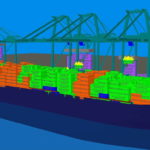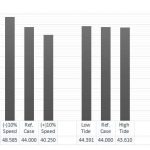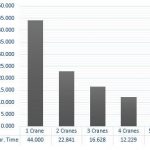Faster and more efficient port operations can allow vessel operators to better plan their journey and save fuel. An improved bay plan arrangement and a Discrete Event Simulation tool can help to improve terminal productivity
Container transportation has been increasing dramatically over the past decades leading us to several concerns regarding efficiency of container ships[ds_preview] and ports operations. Moreover, after the downturn of the global economy in 2008, energy efficiency has become one of the main concerns for maritime operations. Fuel consumptions should be considered as major cost driver in merchant shipping. The simplest way to reduce this cost is to reduce ship speed, which is also called slow steaming.
Bearing in mind these two problems, a solution can be offered by improving operational efficiencies of container terminals. It can increase the service capacity of terminals, reduce operational time of the ships at port and minimize the problems faced due to congestions hence reducing operational expenses. Furthermore, for ship owners, improved container terminal efficiency can let the ships sail for smaller speeds by applying slow steaming strategy, which leads to save combustible as well as to decrease emissions.
Simulation of container terminal operations is a topic that has been studied since the 1970’s and so far, various research cases have been carried out by using different methodologies. In our study case, we focused on the terminal productivity concerns of a new bay plan design for a container ship by using a Discrete Event Simulation (DES) model with a stochastic approach. What makes this approach most reliable is that it allows users to define all equipment existing in a container terminal, to state their physical features (speeds, accelerations, dimensions, locations, etc.) and most importantly to implement uncertainties (such as delays, breakdowns, etc.).
Even though container terminal operations can be highly automated, operational times still cannot be planned very accurately due to many complexities and it causes difficulties for planning the berth occupancy and operational time precisely. By using DES, these complications and the major characteristics of a container terminal can be incorporated into the simulation. Human-, equipment- and climate-related randomness can be introduced by using statistical data thus making it possible to create a system model that gives results closer to reality. For this case study, seven months of operational data have been obtained from a container terminal and statistical analysis has been conducted to generate delays statistical distributions for the simulation.
DES allows users to understand the attributes of the observed system and gives clear results about the bottlenecks of the operations. Similarly, it allows to analyse, without any investment, what is the possible throughput of different strategies or operation alternatives.
The simulation model is created fully parametrically, i.e. reading a database. Comparing other methodologies, it is way faster to perform a simulation. Moreover, it allows the possibility to connect the system to an optimizer. The simulation model has been calibrated and validated with real operation of several ships by respecting same crane allocation, hatch cover movements, different container sizes, etc. Results have shown a difference on gross operational time of about 1.5% between the real operation and the simulation. Gross operational time is defined as the total time spent in between handling first and last container, including idle times.
A new concept of bay plan arrangement of a 4,250TEU container ship was also analysed. This case considers 1,200TEU containers unloaded, 92TEU containers re-handled (unloaded and loaded back due to hatch) and 15 hatch cover openings. The impact on various scenarios has been studied on the gross operational time of the terminal.
Firstly, sensitivity of some physical changes on the system are examined when a single crane operation is set up. A dramatic alteration in operational time is observed, i.e. about 8.5%, when the speeds of cranes are increased or decreased by 10%. Besides that, it has been demonstrated that a tide variation of 0.5m does not affect so much the operational time, i.e. less than 1% difference. Furthermore, using 53% of FEU containers on-board instead of only TEUs, gives the biggest differential with about 24% less operational time.
Decision on the crane number to be used in an operation is an important step which depends on the infrastructure of the terminal, the number of containers to be moved, the size of the ship, the availability of resources, the timing of the current operation and the planned date of a future operation.
This is an aid for a container terminal in deciding how many cranes to use for a specific operation case. For this instance, it can be observed that a difference of only 2.5 hours exists between a four crane and a five-crane operation. This variation is relatively trivial compared to other time differences and the fifth crane can be redundant for this case.
The container terminal and the operator both presented high interest to use this tool to forecast and better schedule their operations. Better container bay plan arrangements and better scheduling at port side can lead to a significant improvement of terminal productivity, and consequently allow the ship owners to adopt slow steaming strategies.
Authors: Rasih Onur Süzen (M.Sc.),
under Erasmus Mundus EM-Ship
fellowship in University of Liege,
ronur.suzen@gmail.com
Prof. Jean-David Caprace (PhD),
Federal University of Rio de Janeiro (UFRJ), jdcaprace@oceanica.ufrj.br
Rasih Onur Süzen, Prof. Jean-David Caprace



















